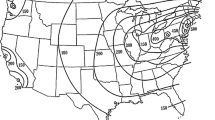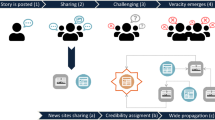Abstract
This research examines the relationship between a country’s position in the international telecommunications (telephone and Internet) network and whether or not it is a state sponsor or a provider of sanctuary for terrorists. It also examines the structure of global news coverage of terrorism. A longitudinal analysis of international telephone calls and Internet traffic, as well as the news coverage among countries, identifies changes in the network structures, which provides an understanding of network dynamics and how they evolve alongside international relations. Changes in the co-occurrences of countries coverage in the international news network were examined to determine how the telecommunication and news coverage networks co-evolve.








Similar content being viewed by others
References
Arquilla J (2007) The end of war as we knew it? Insurgency, counterinsurgency and lessons from the forgotten history of early terror networks. Third world q 28(2):369–386
Arquilla J, Ronfeldt D (2001) Networks and netwars: The future of terror, crime, and militancy. RAND, Santa Monica
Barnett GA (2001) A longitudinal analysis of the international telecommunications network: 1978–1996. Am Behav Sci 44(10):1638–1655
Barnett GA (2004) A longitudinal analysis of the international telecommunication network: 1978–1999. In: Guo Z (ed) Globalization and cultural communication. Beijing Institute Press, Beijing, pp 190–218
Barnett GA (2011) Encyclopedia of Social Networks. Sage, Los Angeles
Barnett GA, Choi Y (1995) Physical distance and language as determinants of the international telecommunications network. Int Polit Sci Rev 16:249–265
Barnett GA, Danowski JA (2002) A longitudinal analysis of the international telecommunications network 1991–2000. Paper presented to the Sunbelt Social Networks Conference, New Orleans
Barnett GA, Lee M (2001) Issues in intercultural research. In: Gudykunst WB, Moody B (eds) Handbook of international and intercultural communication, 2nd edn. Sage, Thousand Oaks, pp 275–290
Barnett GA, Park HW (2005) The structure of international Internet hyperlinks and bilateral bandwidth. Ann Télécommun 60:1115–1132
Barnett GA, Salisbury JGT (1996) Communication and globalization: A longitudinal analysis of the international telecommunication network. J World Syst Res 2(16):1–17
Barnett GA, Chang HJ, Fink EL, Richards WD (1991) Seasonality in television viewing: a mathematical model of cultural processes. Communic Res 18:755–772
Barnett GA, Cho S, Choi Y (1993) Seasonality in television viewing: A dampened oscillation model. Cycles, 137–141
Barnett GA, Chon BS, Rosen D (2001) The structure of international Internet flows in cyberspace. NETCOM 15:61–80
Barnett GA, Chung CJ, Park HW (2011) Uncovering transnational hyperlink patterns and web-mediated contents: a new approach based on cracking.com domain. Soc Sci Comput Rev 29:369–384
Bonacich P (1972) Factoring and weighting approaches to status scores and clique identification. J Math Sociol 2:113–120
Borgatti SP (2002) Netdraw Network Visualization. Analytic Technologies, Harvard
Borgatti SP, Everett MG, Freeman LC (2002) UCINET for windows: Software Of Social Network Analysis. Analytic Technologies, Harvard
Byman D (2005) Deadly connections: states that sponsor terrorism. Cambridge University Press, Cambridge
Carley KM (1999) On the evolution of social and organizational networks. In: Knoke D, Andrews SB (eds) Research in the sociology of organizations: networks in and around organizations. JAI Press, Greenwich
Carter D (2012) A blessing or a curse? State support for terrorist groups. Int Organ 66:129–151
Cruickshank IJ, Evans D (2010) Economic networks and regional instability. Paper presented to the Sunbelt Social Networks Conference, Riva del Garda, Italy
De Maeyer J (2012) Towards a hyperlinked society: A critical review of link studies. New media soc. doi:10.1177/1461444812462851
Dekker D, Krackhardt D, Snijders TAB (2007) Sensitivity of MRQAP test to collinearity and autocorrelation conditions. Psychometrika 72:563–581
Emirbayer M (1997) Manifesto for a relational sociology. Am J Sociol 102:281–317
Emirbayer M, Goodwin J (1994) Network analysis, culture, and the problem of agency. Am J Sociol 99:1411–1454
Fosse E (2011) Two-mode networks. In: Barnett GA (ed) Encyclopedia of Social Networks. Sage, Los Angeles, pp 886–888
Freeman LC (1979) Centrality in social networks: conceptual clarification. Soc Networks 1:215–239
Giddens A (1990) The consequences of modernity. Stanford University Press, Stanford
Gullapalli A, Carley KM (2012) Extracting ordinal temporal trail clusters in networks using symbolic time-series analysis. Soc Netw Anal Min. doi:10.1007/s13278-012-0091-7
Hartman RL, Johnson JD (1989) Social contagion and multiplexity: communication networks as predictors of commitment and role ambiguity. Human Commun Res 15:523–548
Hoffman B (2006) Inside terrorism. Columbia University Press, New York
Horne C, Horgan J (2012) Methodological triangulation in the analysis of terrorist networks. Stud Confl Terror 35:182–192
Jackson MO (2008) Social and economic networks. Princeton University Press, Princeton
Kegley CW, Wittkopf ER (2001) World politics: Trends and transformation, 8th edn. Bedford/St. Martin’s, New York
Keohane RO, Nye JS (1998) Power and interdependence in the information age. Foreign Aff 77(5):81–94
Kim K, Barnett GA (2000) The structure of the international telecommunications regime in transition. Int Interact 26:91–127
Kim JH, Barnett GA (2007) A structural analysis of international conflict: from a communication perspective. Int Interact 33:135–165
Knoke D, Yang S (2008) Social network analysis, 2nd edn. Sage, Thousand Oaks
Krackhardt D (1987) GAP partialling as a test for spuriousness. Soc Netw 9:171–186
Krebs V (2001) Mapping networks of terrorist cells. Connections 24(3):43–52
Lake DA (1992) Powerful pacifists: democratic states and war. Am Polit Sci Rev 86:24–37
Lawson S (2003) International relations: Short introductions. Polity Press, Cambridge
McCulloh I (2009) Detecting changes in a dynamic social network. Dissertation, Carnegie Mellon University
Mickolus EF (1989) What constitutes state support to terrorists? Terror Polit Violence 1:287–293
Moisy C (1997) Myths of the global information village. Foreign Policy 107:78–87
Monge PR (1998) 1998 ICA Presidential Address: communication structures and processes in globalization. J Commun 48(4):142–153
Monge PR, Contractor NS (2003) Theories of communication networks. Oxford University Press, New York
Monge PR, Fulk J (1999) Communication technology for global network organizations. In: DeSanctis G, Fulk J (eds) Shaping organizational form: Communication, connection, and community. Sage, Thousand Oaks, pp 71–100
Monge P, Heiss BM, Margolin DB (2008) Communication network evolution in organizational communities. Commun Theory 18:449–477
Naim M (2003) The five wars of globalization. Foreign Policy 134:29–37
Newman MEJ, Girvan M (2004) Finding and evaluating community structure in networks. Phys Rev E 69(2):026113–026128
Office of the Coordinator for Counterterrorism (2000) Patterns of global terrorism: 1999, US Department of State, Publication #10687, Washington
Park HW, Barnett GA, Chung CJ (2011) Structural changes in the global hyperlink network 2003–2009. Glob Netw 11:522–544
Pfaltz JL (2012) A mathematical model of dynamic social networks. Soc Netw Anal Min. doi:10.1007/s13278-013-0109-9
Raab J, Milward HB (2003) Dark networks as problems. J Public Adm Res Theory 13:413–439
Ressler S (2006) Social network analysis as a approach to combat terrorism: Past, present, and future research. Homel security Affairs 2(2):1–10
Richardson L (2006) What terrorists want: Understanding the enemy, containing the threat. Random House, New York
Robertson R (1992) Globalization: Social theory and global culture. Sage, Thousand Oaks
Rogers EM, Kincaid DL (1981) Communication networks: Toward a new paradigm for research. The Free Press, New York
Rosen D, Barnett GA, Kim JH (2011) Social networks and online environments: when science and practice co-evolve. Soc Netw Anal Min 1:27–42
Sageman M (2008) Leaderless Jihad. University of Pennsylvania Press, Philadelphia
Sheehan IS (2009) Has the global war on terror changed the terrorist threat? A time-series intervention analysis. Stud Confl Terror 32:743–761
Shimko KL (1992) Realism, neorealism, and American liberalism. Rev Polit 54:281–301
Sholte JA (2001) Globalization: a critical introduction. Palgrave Macmillan, New York
Snyder D, Kick E (1979) Structural position in the World System and economic growth, 1955–1970: a multiple-network analysis of transnational interactions. Am J Sociol 84:1096–1126
Sparrow MK (1991) The application of network analysis to criminal intelligence: an assessment of the prospects. Soc Netw 13:251–274
Thelwall M (2009) Introduction to webometrics: Quantitative web research for the social sciences. Morgan & Claypool, San Francisco
Tilly C (2004) Terror, terrorism, terrorists. Sociol Theory 22:5–13
Vertovec S (2004) Cheap calls: the social glue of migrant transnationalism. Glob Netw 4:219–224
Wasserman S, Faust K (1994) Social network analysis: Methods and applications. Cambridge University Press, New York
Weber MS, Monge P (2011) The flow of digital news in a network of sources, authorities, and hubs. J Commun 61:1062–1081
Wu L, Ackland R (2012) How Web 1.0 Fails: The mismatch between hyperlinks and clickstreams. arXiv:1201.6095v1 [cs.IR] 30 Jan 2012
Author information
Authors and Affiliations
Corresponding author
Rights and permissions
About this article
Cite this article
Barnett, G.A., Ruiz, J.B., Hammond, J.R. et al. An examination of the relationship between international telecommunication networks, terrorism and global news coverage. Soc. Netw. Anal. Min. 3, 721–747 (2013). https://doi.org/10.1007/s13278-013-0117-9
Received:
Revised:
Accepted:
Published:
Issue Date:
DOI: https://doi.org/10.1007/s13278-013-0117-9




